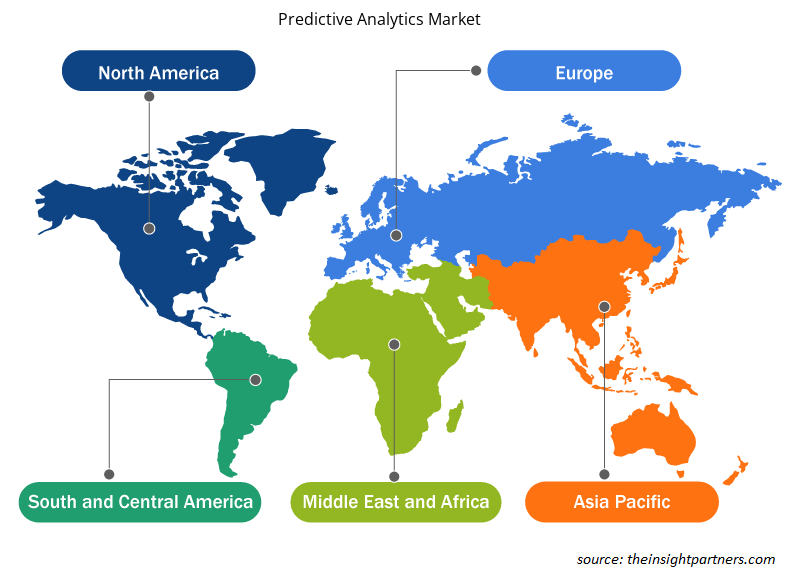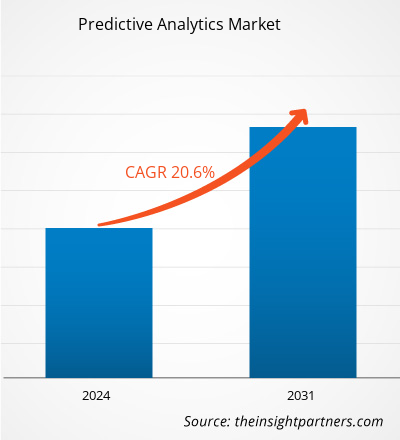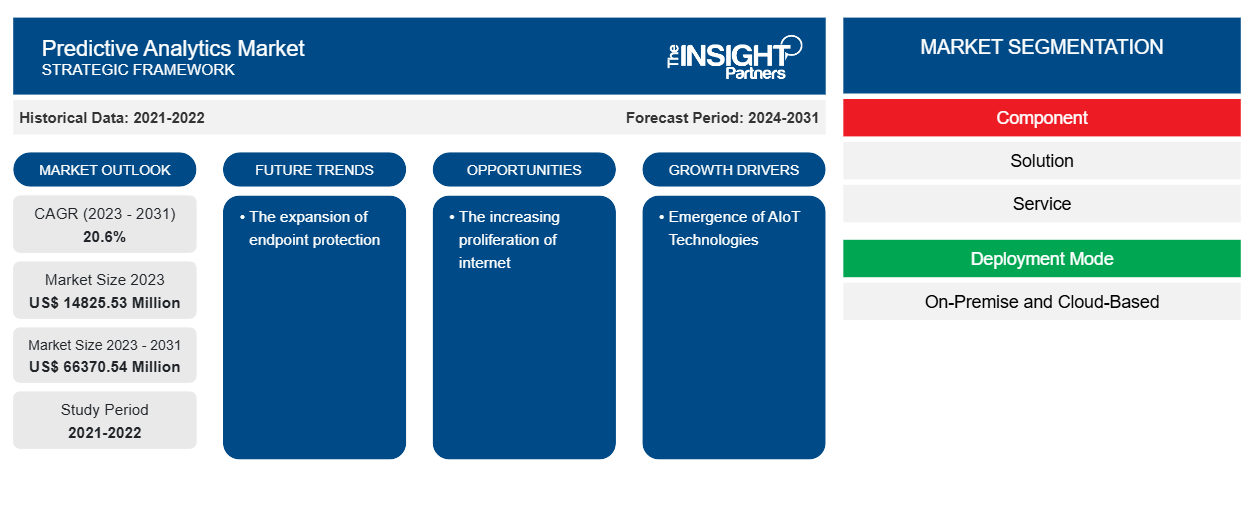Se prevé que el tamaño del mercado de análisis predictivo alcance los 66.370,54 millones de dólares en 2031, frente a los 14.825,53 millones de dólares en 2023. Se espera que el mercado registre una CAGR del 20,6 % durante el período 2023-2031. Es probable que la expansión de la protección de endpoints siga siendo una tendencia clave en el mercado.CAGR of 20.6% during 2023–2031. The expansion of endpoint protection is likely to remain a key trend in the market.
Análisis de mercado de análisis predictivo
Con la adopción generalizada de sofisticadas herramientas de análisis predictivo, las empresas ahora utilizan big data para detectar de forma proactiva posibilidades y peligros. El análisis predictivo es ahora más accesible que nunca gracias a la tecnología moderna. Una corporación necesita identificar un propósito comercial antes de poder utilizar el análisis predictivo, ya sea para aumentar las ventas, optimizar los procesos o mejorar la satisfacción del cliente. Posteriormente, con las herramientas adecuadas, esa organización puede crear modelos de análisis predictivo, producir información procesable y analizar enormes cantidades de datos heterogéneos para lograr ese objetivo.
Descripción general del mercado de análisis predictivo
El análisis predictivo es un subcampo del análisis avanzado que utiliza datos históricos junto con modelos estadísticos, minería de datos y aprendizaje automático para pronosticar eventos futuros. Las empresas utilizan el análisis predictivo para buscar tendencias en estos datos y así identificar posibilidades y peligros. El análisis predictivo se vincula con frecuencia a la ciencia de datos y al big data. Actualmente, las empresas están sobrecargadas de datos, que se almacenan en varios repositorios de datos en toda la empresa e incluyen archivos de registro, fotos y videos. Los científicos de datos emplean algoritmos de aprendizaje automático y aprendizaje profundo para identificar tendencias en los datos y pronosticar eventos futuros con el fin de extraer información valiosa. Las redes neuronales, los árboles de decisión, los modelos de regresión lineal y logística y otras técnicas estadísticas son algunas de ellas. Ciertas estrategias de modelado aprovechan los conocimientos de predicción preliminar para obtener información más predictiva.
Personalice este informe según sus necesidades
Obtendrá personalización en cualquier informe, sin cargo, incluidas partes de este informe o análisis a nivel de país, paquete de datos de Excel, así como también grandes ofertas y descuentos para empresas emergentes y universidades.
-
Obtenga las principales tendencias clave del mercado de este informe.Esta muestra GRATUITA incluirá análisis de datos, desde tendencias del mercado hasta estimaciones y pronósticos.
Factores impulsores y oportunidades del mercado de análisis predictivo
Aparición de tecnologías AIoT
La infraestructura de Internet de las cosas (IoT) y las tecnologías de inteligencia artificial (IA) se unen para formar la inteligencia artificial de las cosas (AIoT). La AIoT busca aumentar la gestión y el análisis de datos, las interacciones hombre-máquina y la eficiencia de las operaciones de IoT. La inteligencia artificial (IA) se utiliza ampliamente en el reconocimiento de voz, la visión artificial y el procesamiento del lenguaje natural. La IA es la emulación de los procesos de inteligencia humana por parte de las computadoras, en particular los sistemas informáticos. Internet de las cosas (IoT) es un sistema de dispositivos informáticos interconectados, maquinaria digital y mecánica, o elementos que pueden comunicar datos a través de una red sin una interfaz de persona a persona o de persona a computadora. La AIoT es revolucionaria y ventajosa para ambos tipos de tecnología, ya que la IA mejora la toma de decisiones y agrega valor a IoT a través de capacidades de aprendizaje automático.IoT) infrastructure and artificial intelligence (AI) technologies come together to form the AIoT). AIoT seeks to increase data management and analysis, human-machine interactions, and IoT operations efficiency. Artificial Intelligence (AI) is widely utilized in speech recognition, machine vision, and natural language processing. AI is the emulation of human intelligence processes by computers, notably computer systems. The Internet of Things (IoT) is a system of interconnected computing devices, digital and mechanical machinery, or items that may communicate data over a network without a human-to-human or human-to-computer interface. AIoT is revolutionary and advantageous to both kinds of technology, as AI improves decision-making and adds value to IoT through machine learning capabilities.
La creciente proliferación de Internet
La penetración de Internet está creciendo a nivel mundial. Por lo tanto, la creciente adopción de alternativas de sistemas de iluminación de túneles ambientales está creando más oportunidades para el mercado. A principios de abril de 2024, había 5.440 millones de usuarios de Internet en todo el mundo, o el 67,1 por ciento de toda la población mundial. Esta asombrosa cifra indica que ahora hay más del doble de usuarios de Internet que de no usuarios, lo que convierte a los usuarios de Internet en una "supermayoría". El número de personas que utilizan Internet también está aumentando; según las cifras más recientes, 178 millones más de personas en todo el mundo se conectaron en el año que finalizó en abril de 2024. Por lo tanto, la creciente proliferación de Internet está creando varias oportunidades para el mercado de análisis predictivo.supermajority." The number of people using the internet is also increasing; according to the most recent figures, 178 million more people worldwide became connected in the year ending in April 2024. Therefore, the increasing internet proliferation is creasting various opportunities for the predictive analytics market.
Análisis de segmentación del informe de mercado de análisis predictivo
Los segmentos clave que contribuyeron a la derivación del análisis del mercado de análisis predictivo son el componente, el modo de implementación, el tamaño de la organización y la vertical de la industria.
- Según el componente, el mercado de análisis predictivo se divide en soluciones (análisis de riesgos, análisis de marketing, análisis de ventas, análisis de clientes y otros) y servicios. El segmento de soluciones tuvo una mayor participación de mercado en 2023.
- Por modo de implementación, el mercado se segmenta en local y basado en la nube. El segmento de la nube tuvo una mayor participación de mercado en 2023.
- Por tamaño de organización, el mercado está segmentado en pequeñas y medianas empresas (PYME) y grandes empresas.SMEs) and large enterprises.
- Por sector industrial vertical, el mercado está segmentado en TI y telecomunicaciones, BFSI, energía y servicios públicos, gobierno y defensa, comercio minorista y comercio electrónico, manufactura y otros.BFSI, energy & utilities, government and defence, retail and e-commerce, manufacturing, and others.
Análisis de la cuota de mercado de análisis predictivo por geografía
El alcance geográfico del informe de mercado de análisis predictivo se divide principalmente en cinco regiones: América del Norte, Asia Pacífico, Europa, Medio Oriente y África, y América del Sur y Central.
La región APAC domina el mercado de análisis predictivo. El mercado de análisis predictivo en esta región está creciendo debido a diversos factores, como el aumento del uso de Internet y los avances tecnológicos. Las empresas de la región están invirtiendo más dinero y energía en identificar soluciones de gestión inteligentes adaptadas a la gestión de las amenazas de seguridad asociadas con los modelos de trabajo desde casa. Por lo tanto, se estima que el dominates the predictive analytics market. The predictive analytics market in this region is growing due to various factors, such as increasing internet usage and technological advancements. Businesses in the region are investing more money and energy into identifying intelligent management solutions tailored to managing security threats associated with work-from-home models. Thus, the mercado de análisis predictivo experimentará un crecimiento sustancial en los próximos años.
Perspectivas regionales del mercado de análisis predictivo
Los analistas de Insight Partners explicaron en detalle las tendencias y los factores regionales que influyen en el mercado de análisis predictivo durante el período de pronóstico. Esta sección también analiza los segmentos y la geografía del mercado de análisis predictivo en América del Norte, Europa, Asia Pacífico, Oriente Medio y África, y América del Sur y Central.

- Obtenga datos regionales específicos para el mercado de análisis predictivo
Alcance del informe de mercado de análisis predictivo
| Atributo del informe | Detalles |
|---|---|
| Tamaño del mercado en 2023 | US$ 14.825,53 millones |
| Tamaño del mercado en 2031 | US$ 66370,54 millones |
| CAGR global (2023 - 2031) | 20,6% |
| Datos históricos | 2021-2022 |
| Período de pronóstico | 2024-2031 |
| Segmentos cubiertos |
Por componente
|
| Regiones y países cubiertos |
América del norte
|
| Líderes del mercado y perfiles de empresas clave |
|
Densidad de actores del mercado de análisis predictivo: comprensión de su impacto en la dinámica empresarial
El mercado de análisis predictivo está creciendo rápidamente, impulsado por la creciente demanda de los usuarios finales debido a factores como la evolución de las preferencias de los consumidores, los avances tecnológicos y una mayor conciencia de los beneficios del producto. A medida que aumenta la demanda, las empresas amplían sus ofertas, innovan para satisfacer las necesidades de los consumidores y aprovechan las tendencias emergentes, lo que impulsa aún más el crecimiento del mercado.
La densidad de actores del mercado se refiere a la distribución de las empresas o firmas que operan dentro de un mercado o industria en particular. Indica cuántos competidores (actores del mercado) están presentes en un espacio de mercado determinado en relación con su tamaño o valor total de mercado.
Las principales empresas que operan en el mercado de análisis predictivo son:
- Corporación IBM
- Corporación Microsoft
- Corporación Oracle
- SAP SE
- Google LLC
- Instituto SAS Inc.
Descargo de responsabilidad : Las empresas enumeradas anteriormente no están clasificadas en ningún orden particular.

- Obtenga una descripción general de los principales actores clave del mercado de análisis predictivo
Noticias y desarrollos recientes del mercado de análisis predictivo
El mercado de análisis predictivo se evalúa mediante la recopilación de datos cualitativos y cuantitativos a partir de investigaciones primarias y secundarias, que incluyen publicaciones corporativas importantes, datos de asociaciones y bases de datos. A continuación, se enumeran algunos de los avances en el mercado de análisis predictivo:
- mPulse, líder en inteligencia artificial conversacional y soluciones de interacción digital para la industria de la salud, anunció un fuerte impulso en el primer trimestre de 2024 en comparación con el primer trimestre de 2023, con un crecimiento en todos los segmentos comerciales. La empresa también anunció el lanzamiento de sus capacidades integradas de análisis predictivo y productos de interacción omnicanal, lo que establece una nueva categoría dentro del ecosistema de salud digital. (Fuente: mPulse, comunicado de prensa, mayo de 2024)
- AVEVA, líder mundial en software industrial que impulsa la innovación y la sostenibilidad, anunció el lanzamiento de su última versión del software AVEVA Predictive Analytics, diseñado específicamente para el monitoreo predictivo de activos industriales en los sectores de petróleo y gas, energía, productos químicos, minería y minerales, y fabricación. El software ayuda a los operadores industriales a lograr los niveles más altos posibles de confiabilidad y rendimiento de los activos industriales, al tiempo que mejora la sostenibilidad y aumenta la productividad de la fuerza laboral. (Fuente: AVEVA, comunicado de prensa, febrero de 2023)
Cobertura y resultados del informe de mercado de análisis predictivo
El informe “Tamaño y pronóstico del mercado de análisis predictivo (2021-2031)” proporciona un análisis detallado del mercado que cubre las siguientes áreas:
- Tamaño del mercado de análisis predictivo y pronóstico a nivel global, regional y nacional para todos los segmentos clave del mercado cubiertos bajo el alcance
- Análisis predictivo de tendencias del mercado, así como dinámicas del mercado, como impulsores, restricciones y oportunidades clave.
- Análisis detallado de las cinco fuerzas de Porter y PEST y FODA
- Análisis de mercado de análisis predictivo que cubre las tendencias clave del mercado, el marco global y regional, los principales actores, las regulaciones y los desarrollos recientes del mercado.
- Panorama de la industria y análisis de la competencia que abarca la concentración del mercado, análisis de mapas de calor, actores destacados y desarrollos recientes para el mercado de análisis predictivo
- Perfiles detallados de empresas
- Análisis histórico (2 años), año base, pronóstico (7 años) con CAGR
- Análisis PEST y FODA
- Tamaño del mercado, valor/volumen: global, regional y nacional
- Industria y panorama competitivo
- Conjunto de datos de Excel
Informes recientes
Testimonios
Razón para comprar
- Toma de decisiones informada
- Comprensión de la dinámica del mercado
- Análisis competitivo
- Información sobre clientes
- Pronósticos del mercado
- Mitigación de riesgos
- Planificación estratégica
- Justificación de la inversión
- Identificación de mercados emergentes
- Mejora de las estrategias de marketing
- Impulso de la eficiencia operativa
- Alineación con las tendencias regulatorias























 Obtenga una muestra gratuita para - Mercado de análisis predictivo
Obtenga una muestra gratuita para - Mercado de análisis predictivo